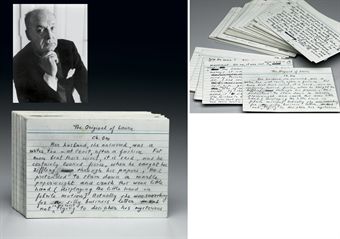Lot Description
NABOKOV, Vladimir (1899-1977). Autograph manuscript of
The Original of Laura, published as
The Original of Laura (Dying is Fun) (Knopf, November 2009). Montreux, Switzerland, 1975-77.
138 index cards (each 4 1/8 x 5 7/8 inches). Written on the rectos of lined index cards in pencil (card 92 ["First (a)"] in blue ink), three on uniformly sized graph paper (cards 1, 65 and 134), numerous authorial corrections, deletions and emendations throughout, 45 cards with pencil Xs on verso, IN AN EXCELLENT STATE OF PRESERVATION.
VLADIMIR NABOKOV'S UNFINISHED FINAL NOVEL: 'THE ORIGINAL OF LAURA'
Falling on a hillside in Davos in 1975 while pursuing his beloved pastime of entomology seemed to set off, in the words of his son Dmitri Nabokov
, Vladimir Nabokov's final period of illness. Despite this, a new work was burgeoning in the author's mind, and during the last two years of his life, Nabokov worked steadfastly on its composition: "He was working on a novel that he had begun in 1975--that same crucial year: an embryonic masterpiece whose pockets of genius were beginning to pupate here and there on his ever-present index cards." As his illnesses progressed, the author instructed his wife Véra Nabokov and his son to destroy the manuscript of
The Original of Laura if he were to die without completing it. As with the chance intervention of Véra Nabokov, who snatched a draft of Lolita before her husband could burn it in an incinerator,
The Original of Laura was likewise preserved: the final work of one the 20th century's greatest literary stylists.
In his diaries, Nabokov made note of the work that would become
The Original of Laura on 1 December 1974, then using the title
Dying is Fun. In the work, the scholar Philip Wild is married to a promiscuous woman named Flora. Death and the afterlife are key themes in the book, as in so many of Nabokov's works, but in The Original of Laura his language is concentrated, with a distilled poetic tautness of immense power. The work opens with a scene at a party, is followed by four continuous scenes and finally fragmentations that reflect Wild's dissipation. His preoccupation with his own death sets him on a course of meditation wherein he sets out to erase himself from the toes up.
Certainly Nabokov's own sufferings as he aged influenced the content of his final work. His own pain, which he felt acutely in his toes, and that of Wild adumbrate one another. The word-play and witticisms, the tuned poetry of diction, the penetrating psychological insights into love and death -- hallmarks throughout Nabokov's career -- appear in
The Original of Laura in crisp and concise form. More than an autobiographical shadow of the author's last years,
The Original of Laura is the final flowering of Vladimir Nabokov's mature art, the quintessence of his creative spirit.
Véra Nabokov could not bear to destroy her husband's last work, nor could Dmitri, their only surviving heir and the translator of many of his father's books. Wrestling with the decision for three decades, Dmitri Nabokov
finally decided to have the work published. Its published form reflects the nature of its manuscript form: each card is photographically reproduced, recto and verso, with the printed transcript beneath. Each leaf is perforated so that they can be removed and rearranged, as Vladimir Nabokov likely did when he was writing the novel.
MANUSCRIPTS BY VLADIMIR NABOKOV ARE EXCEEDINGLY SCARCE ON THE MARKET. According to
American Book Prices Current, no significant manuscript by the author has ever appeared at auction. Vladimir Nabokov's archive was acquired by the Berg Collection, New York Public Library, in 1991 and the Library of Congress collection of Nabokov Papers includes correspondence and manuscripts, including manuscripts or notes for his American novels
Pale Fire, Lolita and
The Real Life of Sebastian Knight. The sale of
The Original of Laura therefore constitutes the ONLY LIKELY OPPORTUNITY TO ACQUIRE A MAJOR WORK BY THE AUTHOR.
Pre-Lot Text
The Property of Dmitri Nabokov
